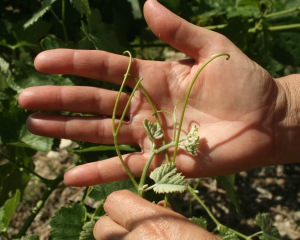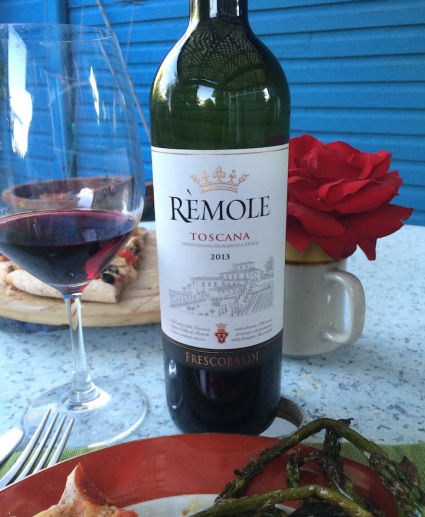Archive
Grape vines pushing out in the new-found heat of summer
The sudden burst of tropic heat arriving in mid-June was just what Colorado’s wine-grape growers were waiting for.

New tendrils on a Merlot vine at Whitewater Hill Vineyards. The long tips show vigorous growth but they are starting to brown, indicating the plant is turning more energy to fruit production and not new growth.
A cool and wetter-than-normal May restored ground moisture to the point many farmers just now are turning their irrigation water into the vineyards and the awakening plants took advantage of the wet conditions to store energy for the summer growing season.
Now that growing season has arrived.
“This is fabulous,” said an obviously pleased Nancy Janes of Whitewater Hill Vineyards and Winery on 32 Road near Grand Junction. “We’re a little behind in development but that’s nothing to worry about, we’ll catch up during the summer.”
On the other side of Grand Mesa, Yvon Gros of Leroux Creek Vineyards was saying his vines of cold-hearty hybrids Chambourcin and Cayuga are redolent with tiny yellow flowers, a sign of a very healthy crop.
“I was walking through the vineyard today and I stopped because I could smell something,” he said. “It was the florescence, the flowering of the vines. It’s a sign that the plants are gearing up for the growing season.”
Gros and his wife Joanna were taking a brief rest during the winery’s Friday dinner marking North Fork Uncorked, a wine-centric celebration of the West Elks AVA, and Joanna paused to remark about how vibrant the vineyard is.
“It’s been years since I’ve seen it so green,” she marveled and pointed to the long, emerald ribbons stretching downslope in front of the inn. “Yvon has been working hard in the vineyard and now this is the result.”

A young cluster of flowers and tiny new grapes. By summers end, given favorable conditions, the cluster will ripen evenly.
When I asked Nancy Janes if the near-constant rain in May was a drawback, she said there initially was some concern about powdery mildew, something moister climates deal with on a regular basis but something seen infrequently in dry western Colorado.
“Wet weather like that isn’t common here but it’s not something we can’t deal with,” she said. “But the plants really are happy to see it warm up.”
Yvon Gros said his vines were “growing like crazy” in the sudden heat.
“Some of the tendrils are 4 to 6 inches long,” he said with delight.
In the vineyard at Whitewater Hill, Janes clutched a vine to show a visitor delicate tendrils of new growth, soft green curls stretching iwell beyond the apical leaf of the vine.
“You see how long and fresh these are? That’s a sign the vine still is sending a lot of energy into growth,” she said. She grabbed another vine and noted the tendrils were starting to die back a little.
“This one is starting to focus its energy on producing fruit and not growth,” she said. “You can see how here we have flowers as well as clusters of green, pepper corn-size grapes.”
She paused and looked down the tidy rows, far different from the wild growth of recent years when vines went unclipped, still recovering from killing freezes in 2013 and 2014.
“It’s great to see the vineyard in shape and looking good,” she said. “Last year we hardly did any pruning at all and it was a jungle but this year John (Behrs, her husband and business partner) and the crews have been working almost constantly retraining and reshaping the vines.”
The fruits of summer
Mid-June and the year’s first crop of serviceberries is ready for harvest.

Ripe serviceberries are deep purple but the lighter berries also are edible. Berries ripen from early June through August.
A member of the rose family, which includes crabapples, cherries, plums, and peaches, the early ripening berries are the size of blueberries and taste a bit grainy and earthy with a hint of dark-berry sweetness.
The berries ripen from June through August, and there are several places I monitor in the nearby mountains where it’s not uncommon to be picking late-summer serviceberries and have competition from black bears enjoying the same crop.
The shrubs, which left untrimmed may grow into small trees, are common in the mountains of Colorado and the West and regional variations are found nearly everywhere. The white blooms appear in early spring, “when the shad runs” according to some legends, which is said to be the root of their other common names shadbush and shadblow.
The shrub’s name has several interesting although unlikely etymologies. One says it was so named because the bush blooms in mid-April, when the roads became clear of snow and allowed the resumption of long-delayed church services. And yet another story says the bush was named because its blooming indicates the ground has thawed enough to allow for graves to be dug and burial services held for people who had died during the winter.
Other common names include sarvisberry, saskatoonberry (it’s said the Saskatchewan city was named after the shrub), wild plum, Alleghany serviceberry and Pacific serviceberry.
The shrubs may reach 20 feet or more and I trim the shrub in my yard every couple of years to keep it manageable. Also, the shrub in my yard blooms twice a year, so I frequently get a both a spring and a fall crop of serviceberries.
The berries are good for nibbling, to put on yogurt and ice cream and also can be dried, frozen and used for jellies, muffins and other uses.
Hot Summer Days – The series continues
Hot time, summer in the city (and everywhere else). The season begs for casual, outdoors entertaining, and that means sharing meals with family and friends at the park, the beach or simply at home on the patio.
Summer dining is dominated by well-chilled crisp white wines and our occasional series on summer wines will get back to those next time.
But if you’re a red-wine lover, summer can be the cruelest season, indeed. Red drinkers often cringe when it comes to summer dining since many people are reluctant or don’t know how to serve red wine in the summer and a 90-degree day normally isn’t conducive to sipping a warm, full-bodied red.

The Marchesi dé Frescobaldi Rémole 2013 is perfect for summer dining. Served slightly chilled, it’s bright flavors match well with casual seasonal dining.
The answers are easy.
A slightly chilled red (yes, it’s OK to do that) is a fine thing in the summer and one wine sure to please the red-crazed masses (and your pocket book) is Marchesi dé Frescobaldi’s Remole, a Toscana IGT blend of Sangiovese (85 percent) and Cabernet Sauvignon (15 percent) with layered aromas of cherries, cranberries, watermelon and spice.
This affordable ($10 MSRP!) is an easy drinking and surprisingly elegant wine that is a favorite for casual entertaining.
The Frescobaldi family history goes back more 1,000 years in Florence and more than 700 years and 30 generations in the Remole area east of Florence.
It’s there, so family legend holds, that sometime in the 1300s poet Dino Frescobaldi smuggled parts of the “Divine Comedy” to another Dante, this one Dante Aligheri, thereby enabling Aligheri to finish his epic masterpiece.
By the 1400s, Frescobaldi wines were being served at the tables of the Papal Court and Henry VIII.
Since then, Frascobaldi wines have continued to win honors and encomia and today the Frescobaldi family makes a wide range of wines, including some of their finest in partnership with the Robert Mondavi family.
The versatile Remole is a terrific pairing for summer barbecue when served slightly chilled (15-20 minutes in the refrigerator is enough), the wine’s bright fruity notes of plum, red raspberry and cherries (retained by hand-picking and four months stainless steel) highlighting the black-sweet fire-char of grilled meats.
And at only 12 percent alcohol, the wine won’t bring an early end to the good times.
Remole Toscana IGT, by Marchesi dé Frescobaldi (professional sample)
Sangiovese 85%, Cabernet Sauvignon 15%
Price: $10
Frescobaldi wines are available widely this summer at Milan’s Expo 2015.
Information: http://www.frescobaldi.it
